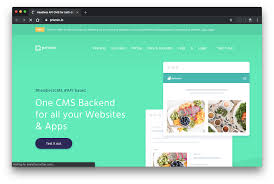A headless CMS is popularly known for its scalability, flexibility, compatibility, optimum security, etc.
All that a headless CMS does is to create, model and authorize contents. It also helps in organizing content repositories. It also supports more than one programming language.
CMS is the short form of Content Management System. The term “Headless” is best known to us as a lack of a frontend.
Contents in a headless CMS is kept and delivered on an API and backend system. A headless CMS has no business trying to connect codes and contents, it uses API calls to make contents available on webpages.
This article will be solely about the best headless CMS we have around us today. Stay focused!
1. Contentful
Contentful supports the common programming languages today through the help of the RESTful API development kits. It is best suited for small to medium scale businesses.

Features:
- Contentful allows you as a developer to use an API and any language and framework of your choice in managing and delivering content.
- You can use contentful content on web applications. Doing this, you have access to all features
2. Directus
Directus is your choice if you are looking for an open-source CMS. It supports projects that have to do with customized databases.

Features:
- It manages your content in a very simple manner.
- You can have it completely decomposed and extensible
- Data entering in it is easy to do
- It looks simple to use
3. Butter CMS
The origin of ButterCMS can be traced back to 2014. It is popularly known for delivering headless CMS and blog engine.

Features:
- It doesn’t require much time in its operation
- It doesn’t need regular maintenance. This means things like hosting, upgrades, security, and performance should be off your mind
4. Prismic
Prismic was established in 2013. Google and eBay are making adequate use of this headless CMS. A team of developers and marketers can launch websites all thanks to Prismic.

Features:
- You are able to use it to schedule and preview
- It fits in well with other resources
- It works for more than one programming language
5. Kentico Kontent
Kentico kontent allows you to consistently produce your content in a single place. This Content-as-a-Service platform is widely common for its rich content operations features.

Features:
- For rendering content in web pages, Kentico kontent makes use of an API that is extremely fast
- You can use it for tracking and analyzing the experience of customers
6. Squidex
Squidex allows users to have total control over data. No matter where you are, at a particular point in time, it gives you access to create and edit content.

Features:
- It is a sophisticated text editor
- It manages documents in a very pretty way
7. Strapi
The idea behind the creation of Strapi is to build a robust API and to provide a developed CMS.

Features:
- It supports the use of extensions
- It has an admin panel that is beautiful, easily customizable and extensible
8. Netlify
Users can use Netlify with any static site generator of their choice for projects that has to do with the web.

Features:
- It is possible for you to add CMS access for any team member with Git Gateway
- Intuitive workflow for content teams
- It has an interface that relates well with users
9. Scrivito
Scrivito is referred to as a cloud-based Javascript CMS. It is created to be used for digital businesses. All thanks to Scritivito, business sites are able to have a super-flexible and trusted foundation.

Features:
- It is an headless SaaS CMS
- You don’t need to worry about maintaining Scrivito
- It depends on ReactJS
- It is highly responsive and secure
10. Appernetic
Appernetic is referred to as a static site generator as a form of service (SaAs). You can use it to create a more secure website that responds in a very fast manner.

Features:
- It organizes data in the right and appropriate manner
- It is fast and secure
- You are able to navigate through file systems through the use of the visual tree view
11. Contentstack
Counterstack was originated in the year 2007. San Francisco-based Built.io happens to be the developers of this headless CMS.

Features:
- Asset and workflow management
- It previews contents
- It provides RESTful APIs
12. Cloud CMS
Cloud CMS was established in 2010. It supports MongoDB, ElasticSearch and Amazon AWS.

Features:
- Adjustable content models
- It contains a search function so that you can be able to perform JSON SQL-like queries
- It possesses an anti-virus scanner
13. Cockpit CMS
Cockpit CMS is widely known as a self-hosted headless CMS. It was established in Wulmstorf, Germany. Cockpit CMS is all about storing and distributing content.

Features:
- Free and Open source
- It makes use of APIs and JSON in delivering and presenting content
14. Craft CMS
Craft CMS was founded in the year 2013. One good thing about this headless CMS is that it allows users to create an experience around their content.

Features:
- Flexible and user-friendly
- It provides live content previews
- Multi-site and asset management
- Localization
15. Storyblok
Storyblok was established in 2017. You can call Storyblok an Austria-based open-source, API-driven headless CMS and eCommerce platform.

Features:
- Content localization
- Content previews
- Asset Management
- Custom fields
Conclusion
It is not a surprise that headless CMS is growing in terms of popularity in our world today. We truly hope you as a developer or business owner finds the 15 headless CMS we have listed and explained in this article helpful.


